
Click the name of a planet to learn more about its visibility in December 2020: Jupiter, Saturn, Mars, Venus, Mercury
Try Stellarium for a precise view of the planets from your location.
Want precise planet rise and set times? Click here for recommended almanacs
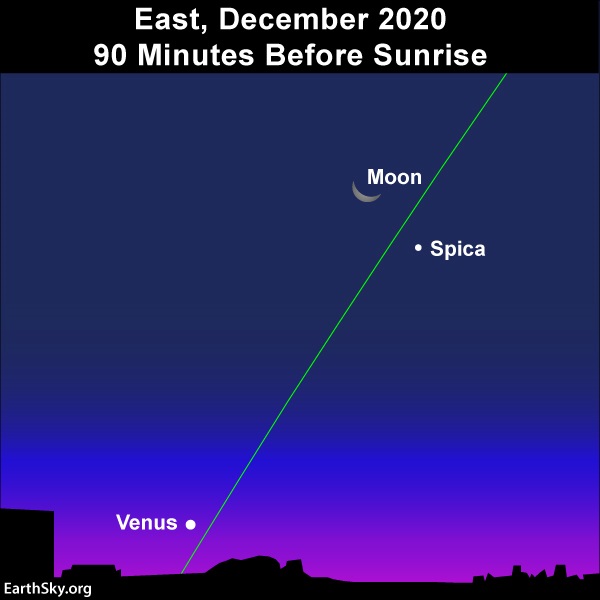
Are you an early riser? Then, on December 10, 2020, look for the moon near the bright star Spica, with the twosome high above the dazzling planet Venus. Read more.
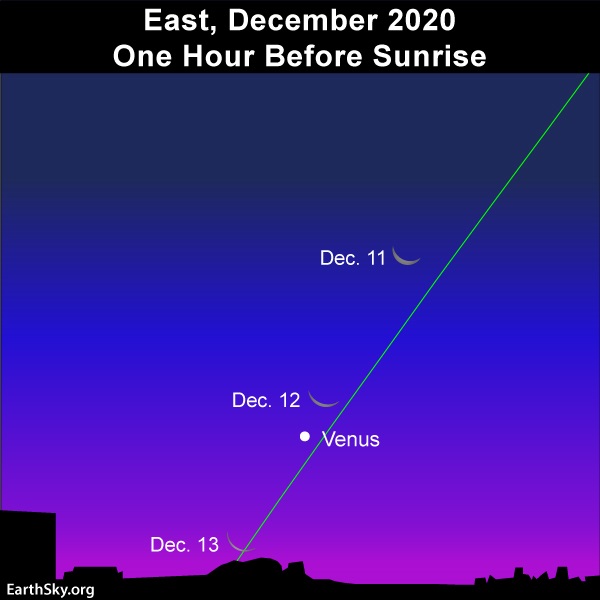
Watch for the slender waning crescent moon to join up with dazzling Venus in the morning sky for several days, centered on or near December 12, 2020. Read more.
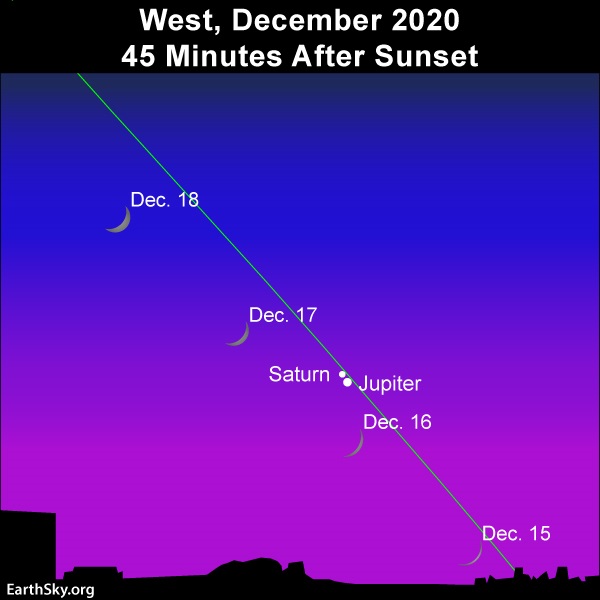
Be sure to catch the young waxing crescent moon in the vicinity of Jupiter and Saturn on December 16 and 17, 2020. Enjoy the celestial couple this month as Venus and Jupiter reach their once-in-20-years great conjunction. Read more.
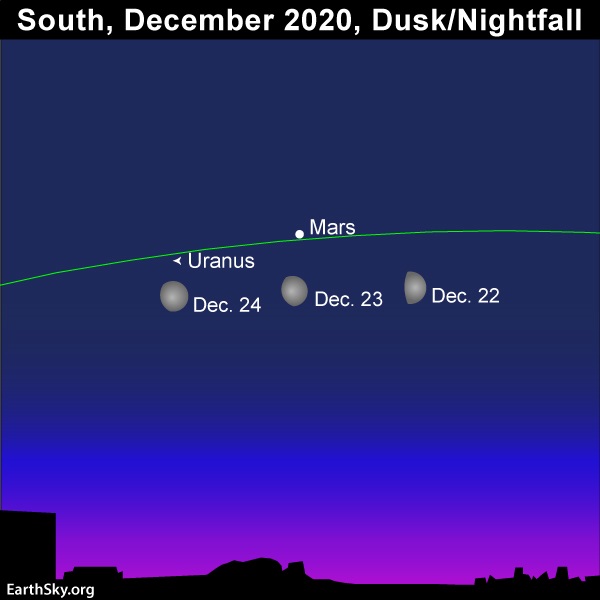
Watch for the waxing crescent moon near the red planet Mars on the sky’s dome for several days, centered on or near December 23, 2020. Note: The moon appears much larger on our chart than it does in the real sky. Read more.
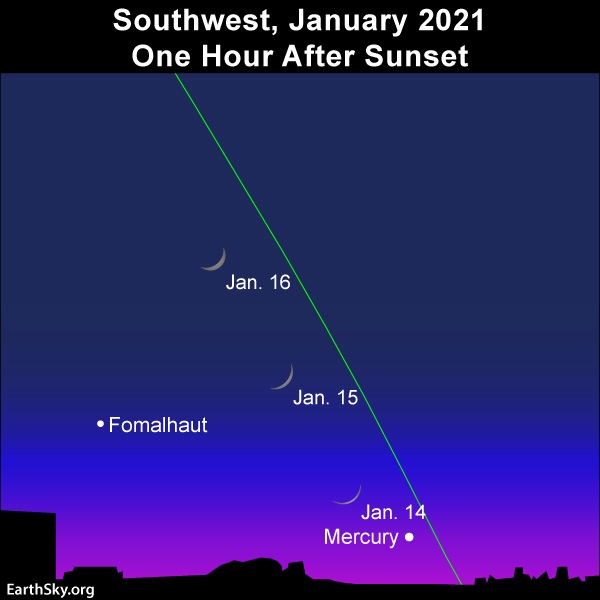
You probably won’t see Mercury, the innermost planet, until January 2021. Let the young moon help you to locate Mercury after sunset on January 14, 15 and 16, 2021. Read more.
Jupiter and Saturn come out first thing at nightfall in December 2020, and will continue to do so until the year’s end. These two worlds appear bright and beautiful at nightfall, though sit low in the southwest sky. Day by day, the twosome appears a bit lower in the sky at nightfall, and set sooner after dark. To see these worlds, find an unobstructed horizon in the direction of sunset, and seek them out rather low in the sky as soon as darkness falls.
Around the world, Jupiter and Saturn set about 3 1/3 hours after the sun in early December. Near the month’s end, the twosome follows the sun beneath the horizon around 1 1/2 hours after sunset.
For the first time since the year 2000, Jupiter and Saturn will have a great conjunction this year, on December 21, 2020. Great conjunctions of these two giant worlds happen every 20 years, but this year’s event will be the closest Jupiter-Saturn conjunction since the year 1623. Astronomers use the word conjunction to describe meetings of planets and other objects on our sky’s dome. They use the term great conjunction to describe a meeting of Jupiter and Saturn. The last great Jupiter-Saturn conjunction was May 28, 2000. The next one will be December 21, 2020. Watch for these worlds to edge closer and closer together throughout the first three weeks of December 2020.
Read more: Before 2020 ends, a great conjunction for Jupiter and Saturn
If you have a telescope, it’s best to use it when Jupiter and Saturn are highest up for the night at dusk/nightfall. In other words, you have to catch them soon after sunset. Typically, the view of Jupiter’s four major moons and Saturn’s glorious rings through the telescope is sharper when these worlds are higher up than lower down. The thickness of the Earth’s atmosphere near the horizon tends to blur the view of Jupiter’s moons and Saturn’s rings.
Positions of Jupiter’s moons via Sky & Telescope
Look first for brilliant Jupiter; Saturn is the bright object immediately to Jupiter’s east for the first three weeks of December. Although Saturn is easily as bright as a 1st-magnitude star – as bright as the brightest stars in our sky – the ringed planet can’t compete with the the king planet Jupiter, which outshines Saturn by some 11 times. After all, Jupiter almost always ranks as the fourth brightest celestial object, after the sun, the moon and the planet Venus, respectively (although Mars temporarily reigned as the fourth-brightest celestial body – and Jupiter as the fifth-brightest – in October 2020).
Watch for the moon in the neighborhood of Jupiter and Saturn for few days, on December 16 and 17.
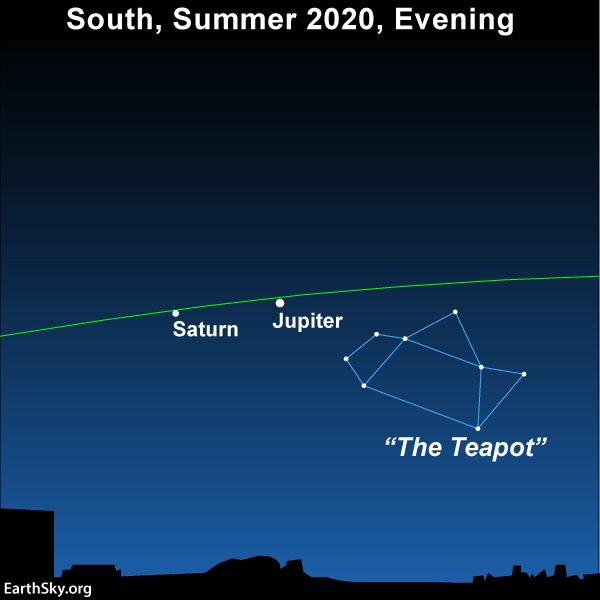
If you notice just one object in the sky after sunset, it might be very bright Jupiter. This planet outshines all the stars, plus it’s near another bright planet, Saturn. You can’t miss these two. Jupiter and Saturn are highest up for the night at nightfall. Before 2020 ends, Jupiter and Saturn will undergo a great conjunction.
Mars lords over the southeastern sky as darkness falls in December from northerly latitudes. From the Southern Hemisphere, Mars is seen high in the northern sky at nightfall. Its fiery-red splendor lights up the nighttime well past midnight. In October 2020, Mars was brighter than it will be again until September 2035. That’s because – on October 13, 2020 – Mars reached opposition in our sky, when it was opposite the sun as seen from Earth. At opposition, Earth was sweeping between Mars and the sun. Now – in its smaller, faster orbit – Earth is now rushing along, leaving Mars behind. Thus, in the months ahead, Mars will slowly but surely dim in our nighttime sky.
Even so, Mars remains bright and beautiful all throughout December. Let the moon help guide your eye to Mars for several nights centered on or near December 23.

View at EarthSky Community Photos. | From Paul Armstrong, who took this photo of Mars, Saturn and Jupiter on the morning of April 15, 2020, from Exmoor, U.K. Jupiter is at the upper right, Mars at center left, with Saturn between them. In May 2020, Jupiter and Saturn were closer together, whereas Mars was farther away from Jupiter and Saturn. Thanks, Paul!
Venus – the brightest planet – reached its greatest elongation from the sun in the morning sky on August 12 or 13 (depending upon your time zone). But dazzling Venus will remain bright and beautiful as a morning “star” for the rest of this year, and for the first few months of 2021.
At mid-northern latitudes, Venus rises about 2 1/2 hours before the sun in early December, tapering down to about 1 1/2 hours by the month’s end.
At and near the equator, Venus rises 1 5/6 hours before the sun in early December, decreasing to 1 1/2 hours by the month’s end.
At temperate latitudes in the Southern Hemisphere, Venus rises a little less than 1 1/2 hours before the sun all through December.
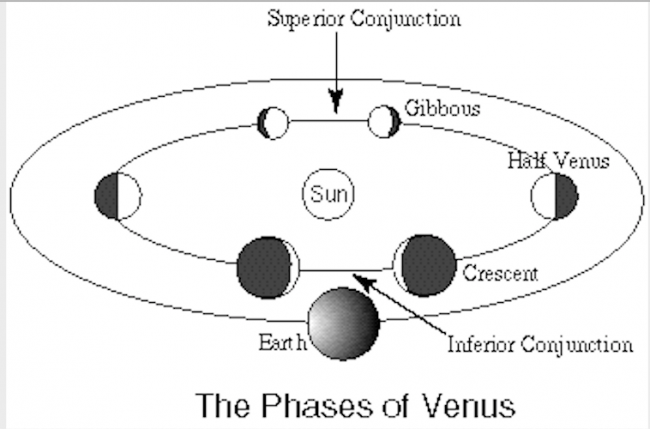
Inferior conjunction – when Venus sweeps between the sun and Earth – happened on June 3, 2020. Some 10 weeks later, Venus reached its greatest elongation in the morning sky on August 13, 2020 (when its disk was about 50% illuminated by sunshine). In December 2020, Venus will start the month about 89% illuminated and then end the month about 94% illuminated. Image via UCLA.
Throughout December, Venus in its faster orbit around the sun will be going farther and farther away from Earth. As viewed through the telescope, Venus’ waxing gibbous phase will widen, yet its overall disk size will shrink. Venus’ disk is 89% illuminated in early December, and 94% illuminated by the month’s end; Venus’ angular diameter, on the other hand, will shrink to about 91% of its initial size by late December.
Watch for the waning crescent moon to shine with Venus in the morning sky for several days, centered around December 12.
Mercury won’t be easy to catch this month from anywhere around the world. Mercury starts out the month in the morning sky and ends the month in the evening sky. Look for this world in your western sky after sunset in January 2021.

You probably won’t see Mercury, the innermost planet, until January 2021. Let the young moon help you to locate Mercury after sunset on January 14, 15 and 16, 2021. Read more.
What do we mean by bright planet? By bright planet, we mean any solar system planet that is easily visible without an optical aid and that has been watched by our ancestors since time immemorial. In their outward order from the sun, the five bright planets are Mercury, Venus, Mars, Jupiter and Saturn. These planets actually do appear bright in our sky. They are typically as bright as – or brighter than – the brightest stars. Plus, these relatively nearby worlds tend to shine with a steadier light than the distant, twinkling stars. You can spot them, and come to know them as faithful friends, if you try.
Bottom line: December 2020 presents three bright planets in the evening sky: Mars, Jupiter and Saturn, plus the brightest planet of them all in the morning sky: Venus. Jupiter and Saturn will have their once-in-20-years conjunction on December 21.
Don’t miss anything. Subscribe to EarthSky News by email
Visit EarthSky’s Best Places to Stargaze to find a dark-sky location near you.
Help EarthSky keep going! Donate now.
Post your planet photos at EarthSky Community Photos.
from EarthSky https://ift.tt/1YD00CF

Click the name of a planet to learn more about its visibility in December 2020: Jupiter, Saturn, Mars, Venus, Mercury
Try Stellarium for a precise view of the planets from your location.
Want precise planet rise and set times? Click here for recommended almanacs

Are you an early riser? Then, on December 10, 2020, look for the moon near the bright star Spica, with the twosome high above the dazzling planet Venus. Read more.

Watch for the slender waning crescent moon to join up with dazzling Venus in the morning sky for several days, centered on or near December 12, 2020. Read more.

Be sure to catch the young waxing crescent moon in the vicinity of Jupiter and Saturn on December 16 and 17, 2020. Enjoy the celestial couple this month as Venus and Jupiter reach their once-in-20-years great conjunction. Read more.

Watch for the waxing crescent moon near the red planet Mars on the sky’s dome for several days, centered on or near December 23, 2020. Note: The moon appears much larger on our chart than it does in the real sky. Read more.

You probably won’t see Mercury, the innermost planet, until January 2021. Let the young moon help you to locate Mercury after sunset on January 14, 15 and 16, 2021. Read more.
Jupiter and Saturn come out first thing at nightfall in December 2020, and will continue to do so until the year’s end. These two worlds appear bright and beautiful at nightfall, though sit low in the southwest sky. Day by day, the twosome appears a bit lower in the sky at nightfall, and set sooner after dark. To see these worlds, find an unobstructed horizon in the direction of sunset, and seek them out rather low in the sky as soon as darkness falls.
Around the world, Jupiter and Saturn set about 3 1/3 hours after the sun in early December. Near the month’s end, the twosome follows the sun beneath the horizon around 1 1/2 hours after sunset.
For the first time since the year 2000, Jupiter and Saturn will have a great conjunction this year, on December 21, 2020. Great conjunctions of these two giant worlds happen every 20 years, but this year’s event will be the closest Jupiter-Saturn conjunction since the year 1623. Astronomers use the word conjunction to describe meetings of planets and other objects on our sky’s dome. They use the term great conjunction to describe a meeting of Jupiter and Saturn. The last great Jupiter-Saturn conjunction was May 28, 2000. The next one will be December 21, 2020. Watch for these worlds to edge closer and closer together throughout the first three weeks of December 2020.
Read more: Before 2020 ends, a great conjunction for Jupiter and Saturn
If you have a telescope, it’s best to use it when Jupiter and Saturn are highest up for the night at dusk/nightfall. In other words, you have to catch them soon after sunset. Typically, the view of Jupiter’s four major moons and Saturn’s glorious rings through the telescope is sharper when these worlds are higher up than lower down. The thickness of the Earth’s atmosphere near the horizon tends to blur the view of Jupiter’s moons and Saturn’s rings.
Positions of Jupiter’s moons via Sky & Telescope
Look first for brilliant Jupiter; Saturn is the bright object immediately to Jupiter’s east for the first three weeks of December. Although Saturn is easily as bright as a 1st-magnitude star – as bright as the brightest stars in our sky – the ringed planet can’t compete with the the king planet Jupiter, which outshines Saturn by some 11 times. After all, Jupiter almost always ranks as the fourth brightest celestial object, after the sun, the moon and the planet Venus, respectively (although Mars temporarily reigned as the fourth-brightest celestial body – and Jupiter as the fifth-brightest – in October 2020).
Watch for the moon in the neighborhood of Jupiter and Saturn for few days, on December 16 and 17.

If you notice just one object in the sky after sunset, it might be very bright Jupiter. This planet outshines all the stars, plus it’s near another bright planet, Saturn. You can’t miss these two. Jupiter and Saturn are highest up for the night at nightfall. Before 2020 ends, Jupiter and Saturn will undergo a great conjunction.
Mars lords over the southeastern sky as darkness falls in December from northerly latitudes. From the Southern Hemisphere, Mars is seen high in the northern sky at nightfall. Its fiery-red splendor lights up the nighttime well past midnight. In October 2020, Mars was brighter than it will be again until September 2035. That’s because – on October 13, 2020 – Mars reached opposition in our sky, when it was opposite the sun as seen from Earth. At opposition, Earth was sweeping between Mars and the sun. Now – in its smaller, faster orbit – Earth is now rushing along, leaving Mars behind. Thus, in the months ahead, Mars will slowly but surely dim in our nighttime sky.
Even so, Mars remains bright and beautiful all throughout December. Let the moon help guide your eye to Mars for several nights centered on or near December 23.

View at EarthSky Community Photos. | From Paul Armstrong, who took this photo of Mars, Saturn and Jupiter on the morning of April 15, 2020, from Exmoor, U.K. Jupiter is at the upper right, Mars at center left, with Saturn between them. In May 2020, Jupiter and Saturn were closer together, whereas Mars was farther away from Jupiter and Saturn. Thanks, Paul!
Venus – the brightest planet – reached its greatest elongation from the sun in the morning sky on August 12 or 13 (depending upon your time zone). But dazzling Venus will remain bright and beautiful as a morning “star” for the rest of this year, and for the first few months of 2021.
At mid-northern latitudes, Venus rises about 2 1/2 hours before the sun in early December, tapering down to about 1 1/2 hours by the month’s end.
At and near the equator, Venus rises 1 5/6 hours before the sun in early December, decreasing to 1 1/2 hours by the month’s end.
At temperate latitudes in the Southern Hemisphere, Venus rises a little less than 1 1/2 hours before the sun all through December.

Inferior conjunction – when Venus sweeps between the sun and Earth – happened on June 3, 2020. Some 10 weeks later, Venus reached its greatest elongation in the morning sky on August 13, 2020 (when its disk was about 50% illuminated by sunshine). In December 2020, Venus will start the month about 89% illuminated and then end the month about 94% illuminated. Image via UCLA.
Throughout December, Venus in its faster orbit around the sun will be going farther and farther away from Earth. As viewed through the telescope, Venus’ waxing gibbous phase will widen, yet its overall disk size will shrink. Venus’ disk is 89% illuminated in early December, and 94% illuminated by the month’s end; Venus’ angular diameter, on the other hand, will shrink to about 91% of its initial size by late December.
Watch for the waning crescent moon to shine with Venus in the morning sky for several days, centered around December 12.
Mercury won’t be easy to catch this month from anywhere around the world. Mercury starts out the month in the morning sky and ends the month in the evening sky. Look for this world in your western sky after sunset in January 2021.

You probably won’t see Mercury, the innermost planet, until January 2021. Let the young moon help you to locate Mercury after sunset on January 14, 15 and 16, 2021. Read more.
What do we mean by bright planet? By bright planet, we mean any solar system planet that is easily visible without an optical aid and that has been watched by our ancestors since time immemorial. In their outward order from the sun, the five bright planets are Mercury, Venus, Mars, Jupiter and Saturn. These planets actually do appear bright in our sky. They are typically as bright as – or brighter than – the brightest stars. Plus, these relatively nearby worlds tend to shine with a steadier light than the distant, twinkling stars. You can spot them, and come to know them as faithful friends, if you try.
Bottom line: December 2020 presents three bright planets in the evening sky: Mars, Jupiter and Saturn, plus the brightest planet of them all in the morning sky: Venus. Jupiter and Saturn will have their once-in-20-years conjunction on December 21.
Don’t miss anything. Subscribe to EarthSky News by email
Visit EarthSky’s Best Places to Stargaze to find a dark-sky location near you.
Help EarthSky keep going! Donate now.
Post your planet photos at EarthSky Community Photos.
from EarthSky https://ift.tt/1YD00CF


Aucun commentaire:
Enregistrer un commentaire